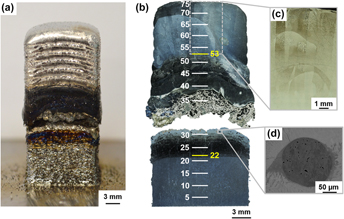Crossref Citations
This article has been cited by the following publications. This list is generated based on data provided by
Crossref.
Zhang, Chi
Chen, Fei
Huang, Zhifeng
Jia, Mingyong
Chen, Guiyi
Ye, Yongqiang
Lin, Yaojun
Liu, Wei
Chen, Bingqing
Shen, Qiang
Zhang, Lianmeng
and
Lavernia, Enrique J.
2019.
Additive manufacturing of functionally graded materials: A review.
Materials Science and Engineering: A,
Vol. 764,
Issue. ,
p.
138209.
Liu, Zi-Kui
2020.
Computational thermodynamics and its applications.
Acta Materialia,
Vol. 200,
Issue. ,
p.
745.
Viet, N. V.
Zaki, W.
and
Wang, Quan
2020.
Free vibration characteristics of sectioned unidirectional/bidirectional functionally graded material cantilever beams based on finite element analysis.
Applied Mathematics and Mechanics,
Vol. 41,
Issue. 12,
p.
1787.
Liu, Yang
Wang, Yachao
Wu, Xin
and
Shi, Jing
2020.
Nonequilibrium thermodynamic calculation and experimental investigation of an additively manufactured functionally graded material.
Journal of Alloys and Compounds,
Vol. 838,
Issue. ,
p.
155322.
Bocklund, Brandon
Bobbio, Lourdes D.
Otis, Richard A.
Beese, Allison M.
and
Liu, Zi-Kui
2020.
Experimental validation of Scheil–Gulliver simulations for gradient path planning in additively manufactured functionally graded materials.
Materialia,
Vol. 11,
Issue. ,
p.
100689.
Wei, H.L.
Mukherjee, T.
Zhang, W.
Zuback, J.S.
Knapp, G.L.
De, A.
and
DebRoy, T.
2021.
Mechanistic models for additive manufacturing of metallic components.
Progress in Materials Science,
Vol. 116,
Issue. ,
p.
100703.
Reichardt, Ashley
Shapiro, Andrew A.
Otis, Richard
Dillon, R. Peter
Borgonia, John Paul
McEnerney, Bryan W.
Hosemann, Peter
and
Beese, Allison M.
2021.
Advances in additive manufacturing of metal-based functionally graded materials.
International Materials Reviews,
Vol. 66,
Issue. 1,
p.
1.
Chaudhary, Varun
Chaudhary, Richa
Banerjee, Rajarshi
and
Ramanujan, R.V.
2021.
Accelerated and conventional development of magnetic high entropy alloys.
Materials Today,
Vol. 49,
Issue. ,
p.
231.
Feenstra, D.R.
Banerjee, R.
Fraser, H.L.
Huang, A.
Molotnikov, A.
and
Birbilis, N.
2021.
Critical review of the state of the art in multi-material fabrication via directed energy deposition.
Current Opinion in Solid State and Materials Science,
Vol. 25,
Issue. 4,
p.
100924.
Yao, Liming
Huang, Sheng
Ramamurty, Upadrasta
and
Xiao, Zhongmin
2021.
On the formation of “Fish-scale” morphology with curved grain interfacial microstructures during selective laser melting of dissimilar alloys.
Acta Materialia,
Vol. 220,
Issue. ,
p.
117331.
Wei, Chao
and
Li, Lin
2021.
Recent progress and scientific challenges in multi-material additive manufacturing via laser-based powder bed fusion.
Virtual and Physical Prototyping,
Vol. 16,
Issue. 3,
p.
347.
Li, Kun
Zhan, Jianbin
Zhang, Ming
Ma, Ruijin
Tang, Qian
Zhang, David Z.
Murr, Lawrence E.
and
Cao, Huajun
2022.
A functionally graded material design from stainless steel to Ni-based superalloy by laser metal deposition coupled with thermodynamic prediction.
Materials & Design,
Vol. 217,
Issue. ,
p.
110612.
Wei, Chao
Gu, Heng
Zhang, Zhizhou
Chueh, Yuan‐Hui
and
Li, Lin
2023.
Additive Manufacturing Technology.
p.
155.
Wei, Chao
Gu, Heng
Zhang, Zhizhou
Chueh, Yuan‐Hui
and
Li, Lin
2023.
Additive Manufacturing Technology.
p.
185.
Yao, Liming
Xiao, Zhongmin
Ramesh, Aditya
and
Zhang, Yanmei
2023.
On the melt pool flow and interface shape of dissimilar alloys via selective laser melting.
International Communications in Heat and Mass Transfer,
Vol. 145,
Issue. ,
p.
106833.
Zhang, Jiarong
Li, Chengning
Ba, Lingzhi
and
Di, Xinjie
2023.
Transition Strategy Optimization of Inconel625-HSLA Steel Functionally Graded Material Fabricated by Wire Arc Additive Manufacturing.
Metals and Materials International,
Vol. 29,
Issue. 3,
p.
767.
Sood, Arjun
Schimmel, Jim
Bosman, Marko
Goulas, Constantinos
Popovich, Vera
and
Hermans, Marcel J.M.
2024.
Fabrication of low thermal expansion Fe–Ni alloys by in-situ alloying using twin-wire arc additive manufacturing.
Materials & Design,
Vol. 240,
Issue. ,
p.
112837.
Sargent, Noah
Firdosy, Samad
Wang, Xin
Ury, Nicholas
Poplawsky, Jonathan D.
Otis, Richard
and
Xiong, Wei
2024.
Discovery of microsegregation-aided transformation and twinning-induced plasticity in low Mn steel through directed energy deposition of functionally graded materials.
Additive Manufacturing,
Vol. 85,
Issue. ,
p.
104154.
Hadji, Lazreg
Madan, Royal
and
Bernard, Fabrice
2024.
Thermal buckling in multi-directional porous plates: The effects of material grading and aspect ratio.
Proceedings of the Institution of Mechanical Engineers, Part G: Journal of Aerospace Engineering,
Vol. 238,
Issue. 4,
p.
412.
Sun Xiaojing, 孙小婧
Yuan Ding, 袁丁
Wei Chao, 韦超
Yang Xiao, 杨潇
and
Li Lin, 李琳
2024.
大物性差异多材料激光增材制造界面研究进展(特邀).
Chinese Journal of Lasers,
Vol. 51,
Issue. 1,
p.
0102003.
